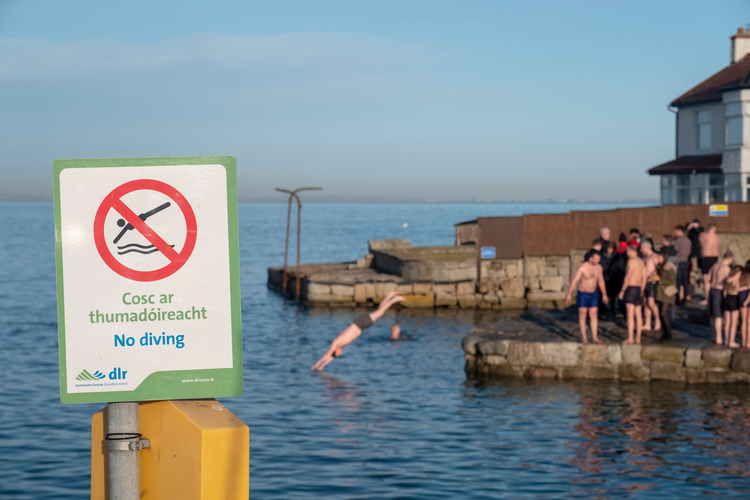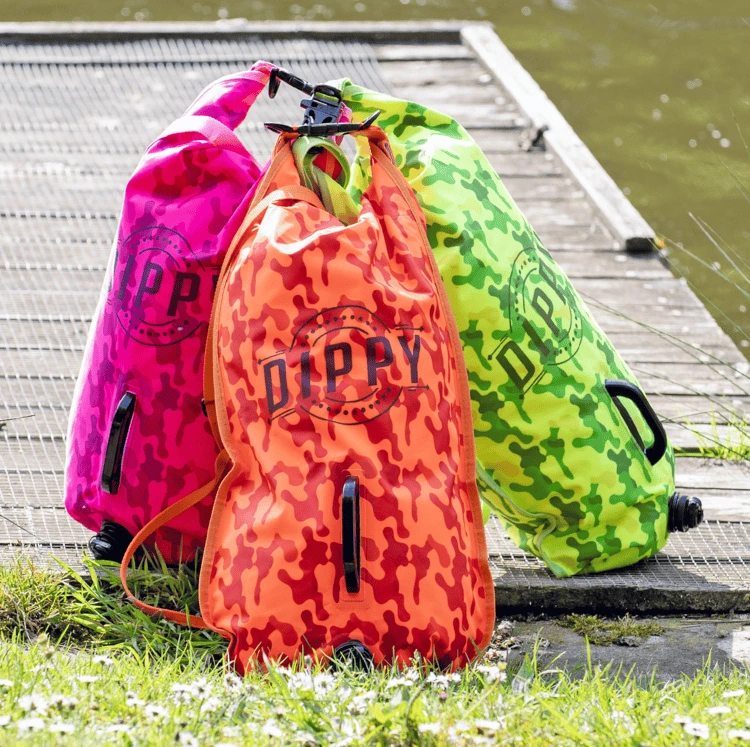
Tristan Kennedy marvels at the cold-water swimmers braving Dublin’s renowned Forty Foot, and the kit you need to do it yourself
They gather here every day, without fail, come rain or shine, in winter and in summer. Even when a cold wind whips up the Irish Sea into a frothing mass of angry white peaks, you’ll find a few brave souls risking life, limb and sanity for a dip in the freezing waters at the spot known as the Forty Foot.
No-one knows exactly when this now-famous outcrop on the south side of Dublin Bay first became popular, but there are records showing that recreational swimmers have been using it for 250 years. The Sandycove Bathers’ Association, which maintains the rudimentary changing huts on site, has been going since 1880. And there are photos of the mass swim on Christmas morning – now an annual tradition – dating back to the early 1970s.
Enjoying this article? Check out our related reads:
Similarly, no-one knows exactly where the name came from. Some believe it was named for a nearby road that was 40 feet wide. Others suggest the name came from the 40th Foot Regiment of the British Army, who apparently swam there when stationed in Dublin in the 1760s. The third theory – that local fishermen named it for the depth of the water – appears to be based either on a gross miscalculation or on the idea that fishermen will exaggerate anything you ask them to measure. Although the spot is deep enough to allow diving from the rocks and swimming at all stages of the tide, the water is, at most, 20 feet deep.
What is without doubt is that the Forty Foot is now a Dublin institution – and one of the best-known cold-water sea swimming spots in the world. It has been immortalised in TV shows, several documentaries, the work of novelist Flann O’Brien and, most famously, in the opening pages of James Joyce’s 1922 masterpiece Ulysses. In the novel, Buck Mulligan – the fictional alter ego of Joyce’s friend, the poet Oliver St John Gogarty – sings the praises of what he calls ‘the snotgreen sea, the scrotumtightening sea’ (a play on the rather more romantic-sounding ‘the wine-dark sea’ in Homer’s original) before going for a morning swim.
The Sandycove Martello Tower, a Napoleonic-era fortification in which Mulligan is staying (and where Joyce himself stayed in 1904, when the novel is set), can still be seen. It’s now a museum dedicated to the author, making the Forty Foot a place of pilgrimage not just for wild-swimming enthusiasts but for his legion of literary fans.

Much has changed since Joyce penned his masterpiece. The Forty Foot used to be (as a historic plaque puts it) a ‘gentleman’s bathing spot’. It wasn’t until after 1974, when a group of feminists staged protest swims at the site, that women became regulars, and the Sandycove Bathers’ Association only allowed women to become full members as recently as 2014. The nudity that was commonplace, if not obligatory, in that gender-segregated era is now in the past. But covering up completely is still not the done thing.
On a recent visit, on a chilly day in December, the vast majority of the swimmers were wearing trunks and costumes rather than wetsuits. The regulars, incredibly, didn’t seem to feel the cold – instead treading water meditatively while engaging in calm conversation. Lots of them stood around chatting after they got out, wrapped only in towels.
I noticed a remarkably wide range of ages in the water – including groups of young lads and mothers with kids. But retirees seemed particularly well represented. Local news reports have previously focused on Forty Foot regulars who kept swimming well into their 90s, proving – if only anecdotally – that cold- water swimming really is good for you.
Of course, you don’t need to be as hardy as South Dublin’s finest to enjoy sea swimming. The sport has taken off in a huge way in recent years – with a report by the website Outdoorswimmer. com estimating that participation numbers grew between 150 and 300 per cent between 2019 and 2022. In a stat that should give the Sandycove Bathers’ Association pause for thought, the number of female participants grew faster than male.
This explosive growth was driven to a large extent by the pandemic, when swimming pools were closed for long periods. But improvements in equipment have also played a role – most notably the development of lower-profile wetsuits that make it easier to move while still keeping you warm. Neoprene gloves and socks have also become increasingly popular, even when worn without a wetsuit, to keep extremities warm.
Tow floats that double as drybags make it easier to venture further offshore, carrying essentials while staying visible to boats and other water users. And while they might not be for the Forty Foot hardcore, drying robes and ponchos help ensure those of us who didn’t grow up on the Irish Sea feel a little more comfortable when we get out.
Whether or not you choose to embrace the wonders of modern technology or prefer to go for the ‘stripped back’ approach favoured by generations of Irish bathers stretching back to Joyce, St John Gogarty and beyond, it’s important to remember that the most essential item for any wild swimming session is a sense of humour. The bathers I saw at the Forty Foot were all shapes and sizes, spanning all ages, classes and nationalities. But apart from the bloody-mindedness needed to swim in the Irish Sea in December, there was one thing that united them: their broad smiles as they did so.
Wishlist – three items to make swimming better
The Luxury: Fourth Element Tidal Robe – £199

Diving brand Fourth Element prides itself on creating innovative equipment while minimising its impact on the planet. This extends from technical gear such as its dive watches to its clothing – such as this Tidal changing robe.
Made from recycled polyester, the outer fabric has a 10k/10k waterproof and breathability rating, with a DWR coating. Inside, there’s a fleece lining that feels warm against the skin. There’s a full-length zip down the front and two capacious handwarmer pockets. It’s designed to pack down small enough to fit in a backpack (or tow-float drybag) and is perfect for slipping on as soon as you come out of the water. fourthelement.com
The Essential: Dippy Swim 28L Drybag Tow float – £33

Unless you’re just paddling in the shallows, a tow float is an essential piece of safety kit for sea swimming. Available in a range of bright colours, this model made by British brand Dippy Swim will ensure you’re highly visible to boats and other water users. As a float, the dual air chambers provide some buoyancy if you run out of puff and need a rest while out swimming, and as a drybag, it enables you to carry valuables (such as car keys, cash and even your phone) with you out on the water.
With fixed handles, a tether, and adjustable waist belts, the bags are designed to cater to all sizes.
Oh, and there’s also a whistle for attracting attention. dippy.store
The Surprisingly Useful: Wild Swimming Socks Humpback – £30

Even if you’re feeling hardcore, like the locals at the Forty Foot, and eschewing a full suit when swimming, a pair of neoprene wetsuit socks are lovely to have. Not only do they keep your toes toasty, they also provide extra protection when navigating spiky rocks and stones in the shallows.
London-based brand Wild Swimming Socks makes them with a variety of different prints, including this humpback whale pattern. The socks are three- millimetre neoprene (similar to a summer surfing wetsuit) with a five-millimetre neoprene sole for extra protection. wildswimmingsocks.co.uk



